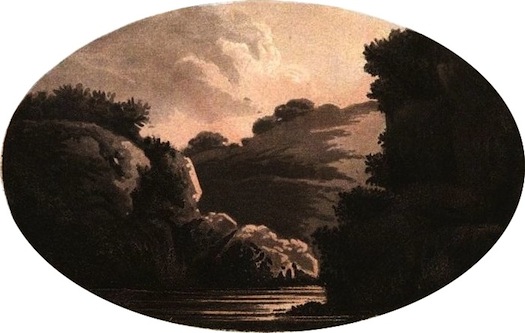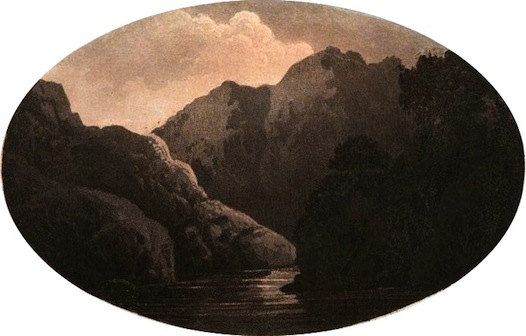The Wye
Next Selection Previous Selection
THE WYE takes it rise near the summit of Plinlimmon, and, dividing the counties of Radnor and Brecnoc, passes through the middle of Herefordshire: it then becomes a second boundary between Monmouthshire and Glocestershire, and falls into the Severn a little below Chepstow. To this place from Ross, which is a course of near forty miles, it flows in a gentle, uninterrupted stream; and adorns, through its various reaches, a succession of the most picturesque scenes. The beauty of these scenes arises chiefly from two circumstances; the lofty banks
of the river, and its mazy course
: both which are accurately observed by the poet, when he describes the Wye as echoing
through its winding
bounds.1
It could not well echo
, unless its banks were both lofty
and winding
. From these two circumstances, the views it exhibits are of the most beautiful kind of perspective, free from the formality of lines. The most perfect river-views, thus circumstanced, are composed of four grand parts: the area
, which is the river itself; the two side-screens
, which are the opposite banks, and lead the perspective; and the frontscreen
, which points out the winding of the river. If the Wye ran, like a Dutch canal, between parallel banks, there could be no front-screen: the two side-screens, in that situation, would lengthen to a point. If a road were under the circumstance of a river winding like the Wye, the effect would be the same. But this is rarely the case. The road pursues the irregularity of the country. It climbs the hill, and sinks into the valley; and this irregularity gives each view it exhibits a different character. The views on the Wye, though composed only of these simple parts
, are yet exceedingly varied
. They are varied, first, by the contrast of the screens
: sometimes one of the side-screens is elevated, sometimes the other, and sometimes the front; or both the side-screens may be lofty, and the front either high or low. Again, they are varied by the folding of the side-screens over each other
; and hiding more or less of the front. When none of the front is discovered, the folding-side either winds round, like an amphitheatre,2
or it becomes a long reach of perspective. These simple
variations admit still farther Variety from becoming complex
. One of the sides may be compounded of various parts, while the other remains simple; or both may be compounded, and the front simple; or the front alone may be compounded. Besides these sources of variety, there are other circumstances, which, under the name of ornaments
, still farther increase them. Plain
banks will admit all the variations we have yet mentioned; but when this plainness
is adorned
, a thousand other varieties arise. The ornaments
of the Wye may be ranged under four heads: ground, wood, rocks
, and buildings
. The ground
, of which the banks of the Wye consist, (and which hath thus far been considered only in its general effect
,) affords every variety which ground is capable of receiving; from the steepest precipice to the flattest meadow. This variety appears in the line formed by the summits of the banks; in the swellings and excavations of their declivities; and in their indentations at the bottom, as they unite with the water. In many places also the ground is broken
; which adds new sources of variety. By broken ground
, we mean only such ground as hath lost its turf, and discovers the naked soil. We often see a gravelly earth shivering from the hills, in the form of water-falls: often dry, stony channels, guttering down precipices, the rough beds of temporary torrents; and sometimes so trifling a cause as the rubbing of sheep against the sides of little banks or hillocs, will occasion very beautiful breaks. The colour
too of the broken soil is a great source of variety; the yellow or the red oker, the ashy grey, the black earth, or the marly blue: and the intermixtures of these with each other, and with patches of verdure, blooming heath, and other vegetable tints, still increase that variety. Nor let the fastidious reader think these remarks descend too much into detail. Were an extensive distance described, a forest exceedingly varied-scene, a sea-coast view, a vast semicircular range of mountains, or some other grand display of nature, it would be trifling to mark these minute circumstances. But here the hills around exhibit little except fore-grounds
; and it is necessary, where we have no distances, to be more exact in finishing objects at hand. The next great ornament on the banks of the Wye are its woods
. In this country are many works carried on by fire; and the woods being maintained for their use, are periodically cut down. As the larger trees are generally left, a kind of alternacy takes place: what is this year a thicket, may the next be an open grove. The woods themselves possess little beauty, and less grandeur; yet, as we consider them merely as the ornamental
parts of a scene, the eye will not examine them with exactness, but compound for a general effect
. One circumstance attending this alternacy is pleasing. Many of the furnaces on the banks of the river consume charcoal which is manufactured on the spot; and the smoke issuing from the sides of the hills, and spreading its thin veil over a part of them, beautifully breaks their lines, and unites them with the sky. The chief deficiency, in point of wood, is of large trees on the edge of the water
; which, clumped here and there, would diversify the hills as the eye passes them; and remove that heaviness which always, in some degree, (though here as little as anywhere,) arises from the continuity of ground. They would also give a degree of distance to the more removed parts; which, in a scene like this, would be attended with peculiar advantage: for as we have here so little distance, we wish to make the most of what we have.—But trees immediately on the foreground
cannot be suffered in these scenes, as they would obstruct the navigation of the river. The rocks
, which are continually starting through the woods, produce another ornament
on the banks of the Wye. The rock, as all other objects, though more than all, receives its chief beauty from contrast. Some objects are beautiful in themselves. The eye is pleased with the tuftings of a tree: it is amused with pursuing the eddying stream; or it rests with delight on the broken arches of a Gothic ruin. Such objects, independent of composition, are beautiful in themselves. But the rock, bleak, naked, and unadorned, seems scarcely to deserve a place among them. Tint it with mosses and lychens of various hues, and you give it a degree of beauty. Adorn it with shrubs and hanging herbage, and you make it still more picturesque. Connect it with wood, and water, and broken ground, and you make it in the highest degree interesting. Its colour
and its form
are so accommodating, that it generally blends into one of the most beautiful appendages of landscape. Different kinds of rocks have different degrees of beauty. Those on the Wye, which are of a greyish colour, are in general simple and grand; rarely formal or fantastic. Sometimes they project in those beautiful square masses, yet broken and shattered in every line, which is characteristic of the most majestic species of rock. Sometimes they slant obliquely from the eye in shelving diagonal strata: and sometimes they appear in large masses of smooth stone, detached from each other, and half buried in the soil. Rocks of this last kind are the most lumpish, and the least picturesque. The various buildings
which arise everywhere on the banks of the Wye, form the last of its ornaments
: abbeys, castles, villages, spires, forges, mills, and bridges. One or other of these venerable vestiges of past, or cheerful habitations of present times, characterize almost every scene. These works of art
are, however, of much greater use in artificial
than in natural
landscape. In pursuing the beauties of nature, we range at large among forests, lakes, rocks, and mountains. The various scenes we meet with, furnish an inexhausted source of pleasure: and though the works of art may often give animation and contrast to these scenes, yet still they are not necessary: we can be amused without them. But when we introduce a scene on canvas; when the eye is to be confined within the frame of a picture, and can no longer range among the varieties of nature, the aids of art become more important ; and we want the castle or the abbey, to give consequence to the scene. Indeed the landscape-painter seldom thinks his view perfect without characterizing it by some object of this kind. 1
Pleas'd Vaga echoes thro' its winding bounds, POPE'S Eth. Ep. 2
The word amphitheatre
, strictly speaking, is a complete inclosure; but, I believe, it is commonly accepted, as here, for any circular piece of architecture, though it do not wind entirely
round.SECTION II.


And rapid Severn hoarse applause resounds.
William Gilpin, Observations of the River Wye, and several parts of South Wales (London: Cadell Junior and W. Davies, 1800) Conversion to HTML and placename mark-up by Humphrey Southall, 2012.

